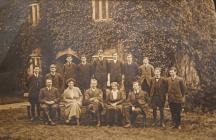Content can be downloaded for non-commercial purposes, such as for personal use or in educational resources.
For commercial purposes please contact the copyright holder directly.
Read more about the The Creative Archive Licence.
Description
This is an image of a finds tray, which is a very common sight on archaeological excavations. These finds are all from one site, the National Botanic Garden of Wales. The estate the Botanic Garden occupies was once the site of a large 17th century mansion, possibly one of the largest and grandest houses within Carmarthenshire (Dollery 2012). In 2011 a 10 day excavation opened up three trenches within the area the original Middleton Hall was thought to have once stood to explore the archaeology and to what extent it has survived (Dollery & Austin 2011). The excavation was extremely successful and the 17th century mansion was discovered along with features relating to a regency, possibly baroque garden as well as large decorative water features (Dollery & Austin 2011).
During the excavation, each feature, layer, deposit, structure, all of which can be described as an ‘event’ is given a context number, and it is though these contexts that the narrative of the past can be deduced (Barker 1982). One of the most important factors with contexts is dating, this is achieved through looking at the material culture that is found, more commonly referred to as ‘Finds’ (Barker 1982). Finds can be any human made objects such as inorganic material; pottery, metal work, worked or shaped stone, flint etc, and organic material; such as bone, leather, wood etc, anything which has been created or altered by our ancestors (Shopland 2005). During the excavation, each context is excavated separately and removed systematically; any finds that are found within each context are also separated, this allows for each context to be dated by the material culture that is found within it (Barker 1982). Trays, like the one in the photograph are partially useful as it ensures material found from a specific context does not get mixed up with material from another context. Dating of archaeological material can be quite complicated as it involves looking at typologies (Shopland 2005). Pottery is a good example of typology analysis dating as throughout history pottery has been changed and adapted frequently, either through the material it is made from to the style and shapes of the vessel. It is therefore possible to look at the form and structure of a piece of pottery to determine what if would have been; i.e., a jug or a bowl; then to work out what it would have looked like, giving an indication of the style. Then by comparing this with the fabric it is made of, it is possible to determine which period it possibly came from as certain styles, fabrics where used in specific periods (Shopland 2005). However this can be tricky as some pottery was used within a short period of time, sometimes within a specific time fame such as 1450 to 1475, whereas other are used for much longer and can span over two centuries.
Austin, D. & Dollery, J. The Excavation. In Austin, D [Ed] 2011 Paradise Lost In Search of a Garden before the Garden: Middleton Hall. Report of project conducted in 2011. Heritage Lottery Fund.
Barker, P. 1982 Techniques of Archaeological Excavation. London. Batsford
Dollery, J 2012 Paradise Rediscovered: Charting the rise and decline of a lost manorial centre in the historic parish of Llanarthney, Carmarthenshire. University of Wales, Trinity Saint David. Unpublished.
Shopland, N. 2005 Archaeological Finds: A Guide to Identification. University of Michigan. Tempus Publishing






Do you have information to add to this item? Please leave a comment
Comments (0)
You must be logged in to leave a comment